Note: the order and ranking is derived from our pre-season ranking. We have simply removed the players that are either no longer in the Atlanta organization or have accumulated enough time in the majors to no longer be considered “prospects”. The original write-ups for those players can be found after the list. We will complete a full re-ranking that incorporates the 2022 draftees after the minor league season concludes. – Ed.
 1. Kyle Muller, LHP
1. Kyle Muller, LHP
Age: 23
3.39 ERA | 4.12 FIP | 17 G, 17 GS | 79.2 IP | 4.74 BB/9 | 10.51 K/9 (AAA)
Acquired: Drafted, 2nd Round – 2016
Prior Ranking: 5
Muller followed up a breakout 2019 season with an even better 2021, excelling in AAA and holding his own in a 9-appearance major league showcase in midseason after a rash of injures prompted Atlanta to give him a look. He had a 2.43 ERA in his first 7 outings, but trouble in his final two starts and the return of Touki Toussaint and Huascar Ynoa from injury prompted the Braves to send Muller back to Gwinnett to continue working on his command.
After building himself up to throw 100 mph in 2019 and 2020, Muller shortened his arm path to help him keep a more repeatable release point, which has helped keep batters from identifying his pitches as early but also has backed the fastball down to the mid-90s. Muller throws both a slider and a traditional curveball, with the slider generating groundballs and the curveball more of a strikeout weapon. Muller has been working on a change-up as well, but he lacks feel. Muller has had control issues at times in the minors, but he is largely passed that now; his main issue is command of his pitches, and he can try to nibble instead of going after batters, causing long counts and baserunners.
Muller will be among the young pitchers looking to be the fifth starter in Atlanta, and even if he doesn’t win the job outright it seems likely he will pitch in the majors in 2022 and may have a significant role.
 2. Bryce Elder, RHP
2. Bryce Elder, RHP
Age: 22
2.75 ERA | 3.60 FIP | 25 G, 25 GS | 137.2 IP | 3.73 BB/9 | 10.13 K/9 (AAA/AA/A+)
Acquired: Drafted, 5th Round – 2020
Prior Ranking: 9
Elder’s body-type and repertoire evokes the word “workhorse”, and that wouldn’t be incorrect. Elder led all affiliated minor leagues in innings pitched in 2021 (followed closely by Stripers teammate Kyle Wright). The ease with which he handled a rapid ascent up the minor league ladder and the improved quality of his stuff since his 5th-round selection out of Texas in 2020 give hope for maybe something more.
Elder possesses some of the cleanest mechanics of the top Braves pitching prospects and pitches with an ease that seems to surprise hitters when his mid-90s four-seam fastball gets to them. That pitch is usually used to set up hitters to swing on top of the low-90s two-seamer or the slider, which is what helps him generate over 50% groundballs at each level and help keep him in games longer than his peers. If hitters don’t want to co-operate with that plan, he can come back with the 4-seamer or his two strikeout secondaries, the curve or the change-up. Patient hitters can draw free passes against him however, but Elder has shown the command to spot the secondaries for called strikes. Improving his command just a tick likely will punch his ticket to the big leagues.
While other pitchers in the top-10 on this list have higher ceilings than Elder, it seems almost inconceivable that Elder won’t end up in a major league rotation, and likely stick there for awhile.
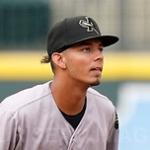 3. Vaughn Grissom, SS/3B
3. Vaughn Grissom, SS/3B
Age: 21 | Bats: R
.319/.418/.464 | 143 wRC+ | 7 HR | 16 SB | 11.8% BB | 14.2% K (A/A+)
Acquired: Drafted, 11th Round – 2019
Prior Ranking: 12
Grissom has gotten the attention of prospect watchers with a superb 2021 for low-A Augusta, getting a cup of coffee with high-A Rome at the end of the season where he acquitted himself well in 12 games. An over-slot pick in the 11th round in 2019 out of the Florida prep school ranks, Grissom is arguably the best pure hitting prospect in the Braves system.
Grissom is balanced at the plate with a smooth swing that shoots the ball to all fields. He gives up some power this way, but almost all of his contact his high-quality and it doesn’t take much imagination to see more power in the future. Grissom has strong pitch recognition as well that should keep him as an on-base threat as he moves up. Defensively he played mostly third base early in the season, then moved back to shortstop later with some second base mixed in. His average arm will probably keep him off third base long-term and its unlikely he’ll have the range for shortstop at higher levels, so second base or a move to the outfield may be in the cards eventually. Grissom is a smart baserunner who reads pitchers well, but likely doesn’t have the speed for double-digit steals at higher levels.
Grissom is a fun prospect right now, and beating projections on his defense or a surge in power would likely get him even more attention. Smart money has him ticketed back to Rome to start 2022, but a good spring may allow the organization to push him to AA.
 4. Freddy Tarnok, RHP
4. Freddy Tarnok, RHP
Age: 22
3.44 ERA | 3.21 FIP | 16 G, 14 GS | 73.1 IP | 3.44 BB/9 | 13.38 K/9 (A+/AA)
Acquired: Drafted, 3rd Round – 2017
Prior Ranking: 13
The Braves knew Tarnok was going to be a slow burn when they drafted him in 2017 given that he’d mostly been a shortstop going into his senior year. That slow burn seemed to catch fire a bit in the second half of 2019, and he used the 2020 lost season to build his arm strength. Despite getting off to a slow start in 2021 thanks to an injury in spring training, Tarnok finally had the big break-out prospect watchers and the organization had been hoping for as he became a rotation mainstay for the championship M-Braves and made himself an easy 40-man roster selection in the off-season.
Tarnok’s stuff ticked up across the board in 2021. After showing off a 99 mph heater in short stints in spring training, he now sits in the mid-90s as a starter. Both his curveball and change-up are now comfortably above average-to-plus offerings. He still has a few outings where feel for the zone isn’t present, but those are becoming rarer. His slider has been relegated to a fourth pitch now, but in the past it has shown promise as well.
Tarnok’s inclusion on the 40-man roster comes at an inopportune time in his development as his spring training will be delayed until the conclusion of the lockout. When he is able to return to the minor leagues there is a good chance he will be challenged with a AAA assignment.
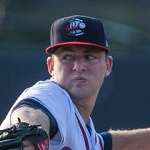 5. Jared Shuster, LHP
5. Jared Shuster, LHP
Age: 23
4.44 ERA | 3.85 FIP | 18 G, 17 GS | 73.0 IP | 2.47 BB/9 | 11.10 K/9 (A+/AA)
Acquired: Drafted, 1st Round – 2020
Prior Ranking: 8
Shuster had a solid if occasionally frustrating first season in pro ball in 2021. After one start for high-A Rome, the Braves pulled Shuster for two weeks to give him a mechanical once-over. When he returned he consistently demonstrated good stuff — a fastball in the low-90s, a solid-average curve, and what is widely regarded as the best change-up in the Braves minors. This was plenty to keep high-A hitters off balance, though stamina was a recurring issue as his pitch count never went over 80 until his final Rome start in late August. Shuster was promoted to AA Mississippi for the final month of the season and he got post-season experience as well with the championship M-Braves. He was crushed in his first AA start, but pitched much better in his follow-up appearances.
The big question with Shuster is what happened to the high-90s fastball that he showed in his final year at Wake Forest. While he doesn’t need that velocity to be an effective pitcher, it could be what separates him from being a potential mid-rotation starter to being a mid-leverage reliever in the big leagues. The curveball showed improvement over the course of the season; early on he hanged it too much for it to be a reliable get-over pitch, but he was able to tighten the break on it as the season progressed. Shuster’s change-up is the bread-and-butter strikeout pitch, and its a doozy, strong enough to carry him to the majors as-is. Shuster has the body and mound presence that looks like someone who could eat innings, and one of the things to watch for early in 2022 is how quickly he’s able to ramp up his pitch count after being treated gingerly for most of 2021.
Shuster seems likely to start 2022 in AA, and to stay there most of the season.
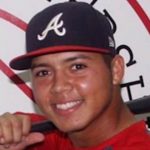 6. Diego Benitez, SS
6. Diego Benitez, SS
Age: 17 | Bats: R
Acquired: International Amateur Free Agent – 2022
Prior Ranking: N/A
The Braves finally rid themselves of the onerous sanctions placed on the team in the wake of the Coppollella bundling scandal and spent a big chunk of their first full international pool allowance on Benitez, a 6′-1″, 190 pound Venezuelan shortstop.
The tools are all evident for Benitez, with bat speed and strength that should allow him to hit for power, a solid approach that should let in hit for average, and and a good fundamental base that should allow him to use his tools at shortstop.
The Braves took a big, aggressive swing in their first full international signing period in awhile, and getting a kid that is drawing Manny Machado comps is a good way to make solid contact.
 7. Braden Shewmake, SS
7. Braden Shewmake, SS
Age: 24 | Bats: L
.228/.271/.401 | 84 wRC+ | 12 HR | 4 SB | 4.9% BB | 21.8% K (AA)
Acquired: Drafted, 1st Round – 2019
Prior Ranking: 11
Shewmake is trying to implement a swing change to add more loft, and at least so far the results have not been great. After going 15-for-111 over the first month of the season it finally looked like Shewmake found his new stroke. From June 15 through the end of July, Shewmake hit .340/.376/.602 with 15 extra base hits, helping Mississippi get to the top of the division, but Shewmake turned cold again down the stretch, going 11-for-69 in September.
Shewmake’s difficulties come when he gets trigger-happy at the plate. He swings early and often, and when AA pitchers figured that out, he rarely got good pitches early in the count. Though he never showed a lot of patience at the plate, before the swing change he could count on his quick hands to allow him to adjust the barrel to make soft contact with the ball. Defensively he continues to play above average shortstop and should be able to keep playing the position at higher levels.
It typically takes more than one season for swing changes to lock in, and Shewmake is certainly a talented enough hitter to make it work. The question now becomes if Shewmake will be able to overhaul his approach to match his swing and what pitchers are doing to him now.
 8. Spencer Schwellenbach, RHP
8. Spencer Schwellenbach, RHP
Age: 21
Acquired: Drafted, 2nd Round – 2021
Prior Ranking: 17
Schwellenbach was a two-way player with Nebraska whom the Braves intend to develop as a starting pitcher. Schwellenbach hit .284/.403/.459 in his final year, and many teams were looking at him as a shortstop, or possible a true two-way player, but at least for now Atlanta has him slated for the mound.
Schwellenbach only pitched his final season, working as the team’s closer. He demonstrated a powerful mid-90s fastball that touched 99 mph. He also has a solid if inconsistent slider and a much better change-up than one would expect from a pitcher of his experience. That looks like a starter’s repertoire to Atlanta, so that’s how he will be developed for now. Schellenbach was considered a potential first round talent, but slid to the second round after it became known that he would require TJS. The Braves have not been afraid of pitchers coming off TJS and have a track record of getting them back on the field.
 9. Ambioris Tavarez, SS
9. Ambioris Tavarez, SS
Age: 18 | Bats: R
Acquired: International Amateur Free Agent – 2021
Prior Ranking: 19
It’s been over 4 years since Atlanta had been able to give an international amateur free agent a signing bonus of more than $300,000, and over 18 months since they’d been able to give a bonus over $10,000 when they signed Dominican shortstop Ambioris Tavarez in 2021.
Tavarez is already a big kid at 6′-2″ and 175 pounds as of last April, with room for more muscle. What stands out about Tavarez is his excellent bat speed which gives him strong raw power and hit tools. While it’s possible he’ll grow out of the position, he shows a strong arm from shortstop. With the Braves electing not to field a Dominican Summer League team, Tavarez spent last summer working out at the complex. It’s likely he will start his pro career in the FCL in 2022.
 10. Victor Vodnik, RHP
10. Victor Vodnik, RHP
Age: 22
5.35 ERA | 4.86 FIP | 11 G, 11 GS | 33.2 IP | 5.88 BB/9 | 10.96 K/9 (AA)
Acquired: Drafted, 14th Round – 2018
Prior Ranking: 14
Injuries derailed what started out as looking like a breakout season for Vodnik. After an impressive spring training, Vodnik was skipped past high-A and began the season with the Mississippi rotation, and he looked up to the challenge for his first three starts. He left early in the fourth start and missed the next five weeks. He wasn’t nearly as sharp upon his return, and he ended up going back on the injured list in mid-August until the end of the season. Vodnik was able to get some work in with the Arizona Fall League, pitching in 6 games (4 starts) with a 5.70 ERA.
When healthy, Vodnik has three potential plus pitches — four-seam fastball, slider, and change-up. As a reliever the fastball can land in the 99 mph range, but it sits 93-96 as a starter. The slider can be a strikeout pitch, and the change-up is a work in progress. Development of the change-up — or some other weapon to neutralize left-handed batters — will be critical in determining his future role after giving up a .346/.493/.618 battling line against lefties in 2021. Vodnik had trouble with control for the first time in his career last season, which could be due to injuries but it will bear watching. Mechanically he’s about as solid as you could hope for, and his competitiveness and mound presence takes a back seat to no one.
There’s always been a high risk that Vodnik will end up as a reliever, and 2021 was supposed to be the season that he showed he had the three-pitch repertoire to succeed as a starter. He will most likely return to AA in 2022 with the goal of staying healthy enough to give Atlanta a better read on him one way or the other.
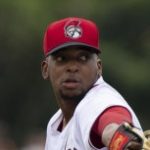 11. Darius Vines, RHP
11. Darius Vines, RHP
Age: 23
2.92 ERA | 4.05 FIP | 22 G, 22 GS | 111.0 IP | 2.35 BB/9 | 10.46 K/9 (A/A+)
Acquired: Drafted, 7th Round — 2019
Prior Ranking: 22
Vines started the season at Augusta where he posted a 2.25 ERA in 8 starts, confounding the typically younger opposition he was facing. He was promoted to Rome in late June was solid in 14 starts, allowing a .214/.263/.388 batting line with a 3.24 ERA.
Vines’s four-pitch repertoire easily overmatched the much-younger competition at Augusta. At Rome some hitters took advantage of his consistency in hitting the strike zone, and he allowed 12 home runs in the 14 games at high-A. Going forward, Vines will need to work on commanding the fastball a little better; when he’s working well, he has good run but when it’s straight it becomes very hittable. He was drafted with a strong curve ball, but it’s the change-up that has progressed the most of his secondary offerings. He’s also working in a slider that so far remains a little loopy and too much like the curve. Vines has nice deception by tunneling all four pitches.
Vines should be pushed to AA to start 2022. He has the potential to be a back-end starter, but we are still projecting a bulk-innings reliever barring an improvement in his stuff.
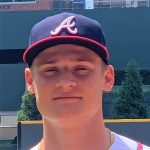 12. A.J. Smith-Shawver, RHP
12. A.J. Smith-Shawver, RHP
Age: 19
8.64 ERA | 8.64 FIP | 4 G, 4 GS | 8.1 IP | 10.8 BB/9 | 17.3 K/9 (AAA)
Acquired: Drafted, 7th Round – 2021
Prior Ranking: N/A
Smith-Shawver was a two-way football/baseball starter in high school who had numerous Division I scholarship offers but made a baseball commitment to Texas Tech. In his limited pro action to date he has struck out 16 of the 38 batters he’s faced, but as also walked 10 others.
Smith-Shawver is perhaps the highest risk/reward selection from last year’s draft, and he has a lot going for him, starting with his 6-3″, 205 pound physique. He also came into the organization with a 95 mph fastball. His secondaries included a slider and a change-up, with word being that the change is ahead right now.
Smith-Shawver could start the season in low-A Augusta, but may also remain in extended spring training depending on his progress.
13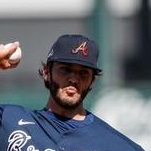 . William Woods, RHP
. William Woods, RHP
Age: 23
4.66 ERA | 7.90 FIP | 4 G, 4 GS | 9.2 IP | 3.72 BB/9 | 6.52 K/9 (A+)
Acquired: Drafted, 23rd Round – 2018
Prior Year Ranking: 30
After wowing Atlanta coaches as a non-roster invitee in spring training with his 99+ mph fastball, Woods was injured late into minor league spring training and it nearly cost him the whole season. He finally got back to game action in late August to make four short starts for high-A Rome at the end of the regular season. Wanting Woods to get more innings in, he made his AA debut in the championship series for Mississippi then headed to the Arizona Fall Lague where he made 6 appearances (5 starts). He threw 21 innings with a 4.29 ERA, a solid performance in a high-offense league.
In short stints, Woods showcases that 99+ mph heater, backed up by a slider. When starting and trying to lengthen his outing, Woods will back the fastball up to the mid-90s and incorporate a developing change-up with good fade to either side of the plate. Currently he’s a control-over-command pitcher, missing over the plate on occassion.
Woods goes into 2022 building off his AFL performance and looking to solidify himself as a starting pitcher, likely back in AA Mississippi. Woods was added to the 40-man roster this offseason, so his season will be delayed by the lockout.
 14. Jesse Franklin, OF
14. Jesse Franklin, OF
Age: 23 | Bats: L
.244/.320/.522 | 118 wRC+ | 24 HR | 19 SB | 8.4% BB | 28.3% K (A+)
Acquired: Drafted, 3rd Round – 2020
Prior Ranking: 15
For a six-week period in June and July last season, there were no hotter hitters in the minor leagues than Franklin. From June 1 through July 15, Franklin hit .310/.393/.770 with 15 home runs for high-A Rome. After that blistering stretch, pitchers began to exploit Franklin’s over-aggressiveness and holes in his pitch recognition and Franklin only hit .214/.302/.453 the rest of the way. Franklin was sent to the Arizona Fall League, where is struggled, going 5-for-51 with only 2 extra base hits.
Coming out of college, Franklin’s swing was long and loopy, and he would regularly get beat by well-placed pitches. He has done a tremendous job altering his swing to have the bat had go directly to the ball, and the resulting increase in bat speed led to his power explosion. Strike zone judgement and pitch recognition lags behind, and once that was recognized Franklin became essentially a mistake hitter. Franklin is athletic and is an above average corner outfielder and baserunner.
Franklin’s first season of 2021 was a 50/50 mix of promise and reasons for caution. Any improvement in his hit tool could drastically improve his outlook. He seems likely to start 2022 in AA Mississippi.
 15. Indigo Diaz, RHP
15. Indigo Diaz, RHP
Age: 23
1.20 ERA | 1.42 FIP | 32 G, 0 GS | 45.0 IP | 3.20 BB/9 | 16.60 K/9 (A+/AA)
Acquired: Drafted, 27th Round — 2019
Prior Ranking: 21
After only getting 6 appearances in the Florida complex league in his pro debut in 2019, Diaz spent the 2021 season putting up video game stats at high-A and AA ball. The only chink in the armor was a seeming wearing down right at the end of the season; this carried over into the Arizona Fall League, where he had a 12.79 ERA in limited action.
There’s not much subtle about Diaz. At 6′-5″, 250 pounds, he strikes an imposing presence on the mound, and follows that up with a rising 4-seamer that can hit 99 mph. He can then finish off hitters with a sharp slider. He throws in and near the zone, so walks weren’t really an issue until very late in the year; again, this is most likely due to fatigue after setting a career high in innings pitched.
Diaz seems likely to be ticketed back to AA Mississippi to start the season, though a AAA challenge wouldn’t be all that surprising. Also not surprising would be a cup of coffee in the majors if his strong performances continues.
 16. Brooks Wilson, RHP
16. Brooks Wilson, RHP
Age: 26
2.34 ERA | 2.14 FIP | 39 G, 0 GS | 50.0 IP | 3.42 BB/9 | 15.12 K/9 (AA)
Acquired: Drafted, 7th Round – 2018
Prior Ranking: 24
Coming off a strong season as a swingman for high-A Florida in 2019, Wilson was installed in the Mississippi bullpen exclusively in 2021 and excelled in a set-up role and then later as a high-leverage reliever. After the M-Braves post-season, Wilson was rewarded with a mid-September call-up to AAA Gwinnett where he was even better, allowing only 1 earned run in 6 innings, striking out 11. Atlanta elected to protect Wilson from the Rule 5 draft by adding him to the 40-man roster after the season.
Wilson was a splitter/curve groundball pitcher as a starter. He used the 2020 lost season to fine-tune a mid-90s four-seem fastball to help change hitters’ eye level, and that increased his strikeouts. The combination of strikeouts and groundouts was a lethal one for Wilson in 2021.
Wilson is one of the biggest prospect victims of the lockout; he hadn’t previously even been a non-roster invitee to major league camp, so he has a lost a prime opportunity to show out in front of Atlanta coaches. Nevertheless, Wilson would seem to be a likely call-up at some point in 2022 with right-handed relief work available.
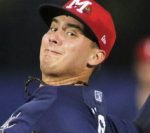 17. Alan Rangel, RHP
17. Alan Rangel, RHP
Age: 24
3.87 ERA | 3.27 FIP | 22 G, 21 GS | 104.2 IP | 2.24 BB/9 | 11.69 K/9 (A+/AA)
Acquired: International Amateur Free Agent – 2014
Prior Ranking: N/A
Perhaps the biggest pleasant surprise of the 2021 season for Braves prospects was the emergence of Rangel from the ranks of likely organizational pitchers to legitimate prospect. Signed as a 16-year-old out of Mexico back in 2014, Rangel has been a solid if unspectacular contributor at the low minor levels. He put the 2020 lost season to good use and came into 2021 with better stuff that translated to his elevation to the AA level and inclusion on the Braves 40-man roster.
Rangel has the same pitches he always has had — a fastball, curve, and change-up. The fastball gained a few miles per hour, his curve gained some tightness, and his change-up added some depth. Put that all together and you get a much more interesting pitcher that has major league potential. Control and command have always been Rangel’s calling card, and he was able to improve his stuff across the board without losing either.
As with Brooks Wilson, the lockout isn’t doing Rangel any favors, though it was far more unlikely that Rangel would be a serious possibility to break camp with Atlanta. Once the lockout ends, look for Rangel to quickly make his way back to Mississippi, where he last pitched in the championship-clinching final game.
 18. Justin Dean, OF
18. Justin Dean, OF
Age: 25 | Bats: R
.237/.345/.364 | 104 wRC+ | 8 HR | 29 SB | 9.9% BB | 30.3% K (AA)
Acquired: Drafted, 17th Round – 2018
Prior Ranking: 23
After the 2020 layoff and a double promotion from low-A Rome in 2019, it probably shouldn’t have been a surprise that it took a little while for Dean to find a groove in AA Mississippi. By the time the season ended however, Dean lead the organization in stolen bases for the second season in a row and more importantly was a spark at the top of the line-up for the championship M-Braves down the stretch, hitting .308/.375/.462 in September.
Despite only measuring in 5′-6″ and 185 pounds, Dean packs a lot of muscle on his frame and has sneaky power, but his bread-and-butter is his wheels. Dean is fast and also a smart and aggressive baserunner who could have double-digit stolen bases in the majors even if relegated to a bench role. Dean’s speed also allows him to be an above average centerfielder, though his route-running is sometimes an adventure. Dean is aggressive at the plate; better pitch recognition would serve him well in keeping from bad counts that lead to strikeouts, but at this point he likely is close to what he will be on that front.
Dean still seems to be on the trajectory for a major league role as a 4th outfielder/pinch-runner/defensive replacement and would seem likely to anchor centerfield for Gwinnett in 2022, at least unless or until Cristian Pache returns to AAA.
 19. Adam Shoemaker, LHP
19. Adam Shoemaker, LHP
Age: 19
6.75 ERA | 5.83 FIP | 3 G, 2 GS | 5.1 IP | 11.81 BB/9 | 10.13 K/9 (FCL)
Acquired: Drafted, 11th Round – 2021
Prior Ranking: 19
Due to the rules of the draft, 11th-round picks are always worth watching. They are almost always players that are highly sought by the drafting team and are guided to Day 3 where each pick has an automatic $125,000 signing bonus allowance that is not part of the overall bonus pool for the team. In 2020, the Braves took Shoemaker with that 11th pick.
Shoemaker is a project for Braves development. At 6′-6″ but only 185 pounds, he likely still has a lot of filling-out to do, which is exciting because his fastball has already been clocked at 95 mph. Shoemaker is a low-mileage arm, having only started pitching his sophomore season of high school, but already has the aforementioned fastball and a heavy sinker, which he used in his limited looks in the FCL to generate 6 ground balls out of 11 balls in play.
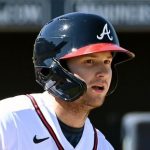 20. Luke Waddell, SS
20. Luke Waddell, SS
Age: 23 | Bats: L
.260/.324/.450 | 104 wRC+ | 6 HR | 2 SB | 9.9% BB | 30.3% K (A+/AA)
Acquired: Drafted, 11th Round – 2021
Prior Ranking: N/A
A senior sign out of Georgia Tech, Waddell took about two weeks at Rome to get used to the wooden bat game then shot up like a bottle rocket. Waddell was promoted to Mississippi in early September to help the M-Braves’ championship run, then went to the Arizona Fall League where he hit .312/.394/.393 in 18 games.
Waddell is 5′-9″ and 180 pounds and makes his living out of being a tough out. He has a short, quick stroke that can zip pitches up the middle or into gaps. His six home runs in 78 plate appearances with Rome was a bit of a surprise and I don’t see that kind of power showing up again, but it was good to see its there if pitchers don’t take him seriously. Waddell is a solid fundamental defender at all three infield skill positions.
Only a half a year into his pro career, Waddell seems almost a finished product, with major league utility infielder upside.
 21. Jasseel De La Cruz, RHP
21. Jasseel De La Cruz, RHP
Age: 24
7.03 ERA | 5.12 FIP | 20 G, 15 GS | 56.1 IP | 5.27 BB/9 | 8.79 K/9 (AAA)
Acquired: International Amateur Free Agent – 2015
Prior Ranking: 16
Pretty much nothing went right for De La Cruz in 2021. Despite having a solid spring training pitching in relief for Atlanta, De La Cruz was put back in the rotation at AAA Gwinnett after two relief appearances, and the transition back to starting did not go well. After holding batters to a stingy .212/.291/.312 batting line in 2019, hitters knocked De La Cruz around to a .278/.373/.454 clip in 2021. Left-handers were particularly unkind to the hard-throwing righty, accumulating a .916 OPS. De La Cruz also missed a month late in the year with an undisclosed injury.
De La Cruz has a three-pitch arsenal of mid-to-high 90s 4-seamer, an above average slider, and a change-up. De La Cruz seemed to lose all feel for the change-up over the course of the season, a big reason why lefties were able to hit him so hard. Both his control and command went backward as well, seemingly getting worse as the season progressed. This resulted in both more walks and more hits against him.
After a fantastic 2019 season that saw De La Cruz cruise through three minor league levels and enter the Braves top 10 prospects, 2021 was a bitter disappointment. De La Cruz ended up being non-tendered from the 40-man roster, which made him a free agent, but he signed back with Atlanta on a minor league deal. While a professional setback for certain, a silver lining is that he will be able to work with Braves staff in minor league spring training and head back to AAA without worrying about the lockout.
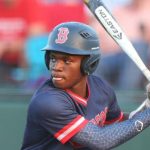 22. Tyler Collins, OF
22. Tyler Collins, OF
Age: 19
.347/.424/.453 | 140 wRC+ | 0 HR | 12 SB | 8.2% BB | 27.1% K (FCL)
Acquired: Drafted, 8th Round – 2021
Prior Ranking: N/A
Atlanta thought enough about the Texas prep star that they went overslot in the 8th round to nab him, and so far the strategy seems to be working as he won the FCL Braves slash-line triple crown, leading the team in batting average, on-base percentage, and slugging percentage despite not hitting a home run.
Collins’ game is speed, and his current profile is that of a classic, old-school lead-off hitter. He chokes up on the bat and slaps the ball on the ground and uses his legs to get on base. This is not a profile that works much in the modern game, and I expect the Braves to work with Collins to put a little more loft on the ball to find more gaps over the infielders heads.
Collins could start the season as Augusta’s centerfielder, but more time in extended spring training would not be a surprise.
 23. Drew Lugbauer, 1B/C
23. Drew Lugbauer, 1B/C
Age: 25
.223/.331/.453 | 117 wRC+ | 18 HR | 0 SB | 12.0% BB | 37.4% K (AA)
Acquired: Drafted, 11th Round – 2017
Prior Ranking: N/A
The introduction of the designated hitter rule to the National League will be a welcome development for “Slugbauer”, who has made himself into an effective three-true-outcomes style hitter after hitting 18 homers, walking at a 12% rate, and striking out at a 37.4% rate for AA Mississippi. He will need to drop the strikeout rate to make it to the big leagues, but the potential for a major league pinch-hitter/emergency catcher is there.
Lugbauer should move up to AAA Gwinnett to start the 2022 season.
 24. Justyn-Henry Malloy, 3B
24. Justyn-Henry Malloy, 3B
Age: 22
.270/.388/.434 | 126 wRC+ | 5 HR | 4 SB | 16.3% BB | 20.4% K (A)
Acquired: Drafted, 6th Round – 2021
Prior Ranking: N/A
The 6th-round pick in the most recent draft out of Georgia Tech, Malloy showed an advanced bat for low-A Augusta, hitting .271/.388/.434 with 5 homers in 37 games. The bat will have to keep carrying him; while ostensibly a third baseman, he hasn’t shown good reactions there and seems likely to end up in an outfield corner or first base.
Malloy should advance to high-A Rome and should get plenty of reps at third base to see if he can avoid the move to a lower position on the defensive spectrum.
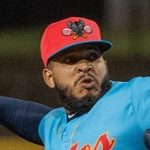 25. Daysbel Hernandez, RHP
25. Daysbel Hernandez, RHP
3.83 ERA | 3.65 FIP | 36 G, 0 GS | 42.1 IP | 4.89 BB/9 | 12.33 K/9 (AA/AAA)
Acquired: International Amateur Free Agent – 2015
Prior Ranking: 27
After struggling to start the season, Hernandez added a change-up to his high-90s 4-seamer and slider, and it propelled him back to AAA before the end of the season. Unfortunately, Hernandez suffered a UCL tear pitching this off-season in the Mexican Winter League and will miss the 2022 season. Hernandez was not protected for the Rule 5 draft and I would not have been surprised to see a team pick Hernandez and stash him on the injured list all season, a trick the Braves did with right-hander Dan Winkler during the rebuild years, but the major league portion of the rule five draft was cancelled this year due to the lockout.
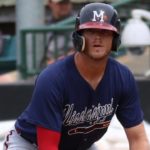 26. Greyson Jenista, OF/1B
26. Greyson Jenista, OF/1B
Age: 19
.216/.343/.465 | 124 wRC+ | 19 HR | 7 SB | 15.5% BB | 35.9% K (AA)
Acquired: Drafted, 2nd Round – 2018
Prior Ranking: N/A
First the good news — after several years of working on a swing that would help Jenista tap into his raw power more consistently, the work bore fruit as he hit 19 homers and 28 extra base hits. The bad news — Jenista’s transformation into a three-true-outcomes hitter ended up with him posting a 35.9% K-rate for AA Mississippi. He still draws his walks, so with the improved power swing it wouldn’t take that much of an improvement in not giving away at-bats to significantly enhance Jenista’s chances.
Defensively, Jenista is more athletic than his 6′-4″, 210 pounds would lead one to believe and he can capably handle either corner outfield spot or first base. His 7 stolen bases was a career high and he’s a smart baserunner than can pick his spots. He will remain in the high minors, looking to restore his prospect shine by making more contact.
Others of Note:
-
- Douglas Glod, OF. Glod received the second highest signing bonus from Atlanta in the 2022 signing period after shortstop Diego Benitez. Glod has potential above average tools across the board and could stick in center field.
- Brandol Mezquita, OF. Mezquita saw across-the-board improvement in his performance his second time through with the Florida complex team, with his .402 OBP allowing him to use his wheels to rack up 15 stolen bases. Best of all, he lowered his groundball rate by 16%. Now at age 20, Mezquita should finally get advanced to full-season ball to start 2022.
- Cal Conley, SS. Conley had a slow start to his pro career, only hitting .214/.304/.307 for low-A Augusta after being selected in the 4th-round out of Texas Tech. Of course 35 games isn’t enough to come to any final conclusion about his bat, but more surprising was his lackluster defensive play. His lack of arm had him manning second base by the end of the season. Still, he seems likely to advance to Rome to start 2022.
- Jared Johnson, RHP. Johnson was one of the Day 3 prep selections in the 2019 draft. The big righty from Mississippi is raw and poor control (in the strike zone) had him on the ropes for most of his Augusta starts, but there’s a lot of arm talent here.
- Drew Campbell, OF. A star at the University of Louisville, Campbell has shown the ability to make his high-contact swing work, but injuries and the pandemic have so far limited him to 223 pro plate appearances.
- Dylan Dodd, LHP. Considered by many draft evaluators to be the best senior pitcher in the 2021 draft, the Braves used a 3rd-round pick to bring the Southwest Missouri State alum into the fold. Dodd comes with four solid pitches, but caught too much of the strike zone in his brief time with Augusta.
- Corbin Clouse, LHP. A 27th-rounder back in 2016, the lefty reliever was knocking on the door of the majors in 2019 when he had to have shoulder surgery. He was able to come back to AA Mississippi for the last 4 weeks of the season where he pitched well.
The Next Ten:
- Tyler Owens, RHP
- Landon Stephens, 1B/OF
- Brandon White, RHP
- Thomas Burrows, LHP
- Mahki Backstrom, 1B
- Stephen Paolini, OF
- Justin Yeager, RHP
- Odalvi Javier, RHP
- Nolan Kingham, RHP
- Trey Riley, RHP
 Michael Harris, OF
Michael Harris, OF
Age: 21 | Bats: L
.294/.362/.436 | 114 wRC+ | 7 HR | 27 SB | 8.3% BB | 18.1% K (A+)
Acquired: Drafted, 3rd Round – 2019
Prior Ranking: 1
GRADUATED! He was #1 on this list.
Harris had a strong season overall at high-A Rome following an attention-grabbing spring training. One thing we like to see from young prospects is for them to struggle and then bounce back, and Harris did that. After a hot start, he cooled off as the weather got warm and pitchers began to exploit his over-aggressiveness that seemed to amplify as the Rome squad as a whole had difficulties scoring runs. By the end of the season Harris had adjusted and started to lay off more pitches, resulting in a .430 OBP over the last five weeks of the season.
Harris has a classic left-handed swing that can generate power to all fields. His 7-homer tally may seem sparse, but more balls will start going over the fence as he physically matures and opposing pitchers throw more around the plate. His improved plate discipline in the second half of the season was a big development. Harris also excelled in the field, where he looked much more natural in centerfield than in 2019 when he first arrived in Rome and looked a little awkward in right. He’s the best defensive outfielder in the system right now excepting Cristian Pache, and the gap between Harris and Pache is smaller than Harris and the rest of the field, showing good jumps and routes plus the athleticism to make five-star catches. He still seems less assured in the corner spots, but no doubt he would adapt if required to play there a majority of the time. Harris is also a strong and smart baserunner both in taking extra bases and stealing them.
Look for Harris to make his AA debut on Opening Day in 2022, with an eye to challenging for a major league role as soon as 2023 as a 22-year-old.
 Cristian Pache, OF
Cristian Pache, OF
Age: 23 | Bats: R
.265/.330/.414 | 100 wRC+ | 11 HR | 9 SB | 8.5 BB% | 27.5 K% (AAA)
Acquired: International Amateur Free Agent – 2015
Prior Ranking: 2
On Monday, March 14, Cristian Pache was traded to the Oakland A’s. He was #2 on this list.
After having been handed the Braves centerfield job out of spring training, Pache fought a deep slump and groin and hamstring issues right out of the gate. He was sent back to Gwinnett in mid-May and never returned to Atlanta. Pache continued to struggle, but his swing returned with his health, and by July was looking more like his old self. After mid-July, Pache hit a respectable .283/.349/.444 with 8 home runs and flashed the Gold Glove-caliber defense that has been a mainstay of his pro career.
When healthy and seeing the ball well, Pache has a quick, repeatable swing that generates easy power pull-side. He looked to be consciously trying to hit for opposite-field power during spring training to mixed success; for now he’s probably best served hitting how he is more comfortable. After improving tremendously in getting the ball off the ground, he had trouble getting the ball into the air in the first half of the season. This, like everything else about his offensive game, improved as the season progressed. Pache has plus speed on the bases and is good at taking extra bases, though he has never been a good base-stealer.
Pache will go back to spring training looking to once again change his “Centerfielder of the Future” tag to “Centerfielder of the Present”. If Ronald Acuna Jr. is unable to start the season there will be spots up for grab. There is no better defender in the Braves organization, but he will have to show quickly that he will hit enough to maintain a spot in the line-up. With Adam Duvall showing he can credibly play good enough center field to hold down the position, the team will not be obligated to hand him a spot on a squad that is looking to repeat as champions.
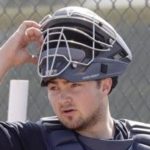 Shea Langeliers, C
Shea Langeliers, C
Age: 24 | Bats: R
.256/.339/.494 | 127 wRC+ | 22 HR | 1 SB | 10.2% BB | 26.8% K (AA/AAA)
Acquired: Drafted, 1st Round – 2019
Prior Ranking: 3
On Monday, March 14, Shea Langeliers was traded to the Oakland A’s. He was #3 on this list.
Perhaps no Brave made better use of his time at the Alternate Training Site in 2020 than Shea Langeliers. Already established as the top defensive catcher in the Braves system, Langeliers was able to execute a change in his swing that paid big dividends for him and the AA-South champion Mississippi Braves as he lead the team with 22 home runs, the most hit by an M-Brave in ten seasons.
Langeliers’s new swing has helped him drop his groundball rate by over 9% from his 2019 efforts, transforming his ceiling outlook from a top-notch defensive catcher who should hit enough to play to a top-notch defensive catchers who could rank among the offensive leaders at the position. The added power however has not made him pull-happy; in fact, he showed an increased proclivity to use all fields last season. Behind the plate, Langeliers has a cannon arm and was one of the top catchers at cutting down runners despite moving to the one-knee-down catching style now favored in the organization. He caught a combined no-hitter and received top marks from his pitchers.
Langeliers got a small taste of AAA after AA Mississippi’s season concluded and will almost certainly start there in 2022. With Travis d’Arnaud, Manny Pina, and William Contreras all on the 40-man roster already there shouldn’t be a need to bring him up to the majors prematurely as Contreras was. Langeliers will likely spend all of 2022 in Gwinnett barring yet another emergency at the major league level at the catcher position.
 Drew Waters, OF
Drew Waters, OF
Age: 23 | Bats: S
.240/.329/.381 | 94 wRC+ | 11 HR | 28 SB | 10.2% BB | 30.9% K (AAA)
Acquired: Drafted, 2nd Round – 2017
Prior Ranking: 4
On Monday, July 11, Drew Waters was traded to the Kansas City Royals. He was #4 on this list.
To say the 2022 season had its ups-and-downs for Waters would be an understatement. While Waters had some sustained production in the middle of the summer, a slow start and a rough end of the season sapped his numbers. To make matters worse, in some ways Waters seems to have regressed at the plate when it comes to approach.
While the negative effects of high strikeout rates are often overstated by fans and broadcasters, strikeout rates above ~25% do start limiting impact. Waters is an extremely aggressive hitter, and pitchers with good control can exploit this as his pitch recognition lags behind his other offensive skills and Waters gives away too many at-bats after falling behind in the count. That said, it’s not all doom-and-gloom for the Etowah Hight School product. One positive development has been his improvement as a right-handed hitter; this was his weaker side coming up through the minors, but he hit .271/.360/.421 as a right-hander.
Waters is equally as aggressive on the bases and in the field as he is at the plater, though the outcomes are typically better. Waters has a plus arm, and enjoys showing it off, seeking to throw out runners trying to take an base. If Waters has a fault in the field, he occasionally will allow a ball to get past him while peeking at a baserunner. Waters will take the extra base himself and he will victimize any fielder who lets his attention wander.
While 2021 wasn’t the season either Waters or the Braves were likely hoping for, given that Waters was only 22 years old and playing the whole season at the AAA level it shouldn’t be a surprise that he had some struggles. While he was added to the 40-man roster this offseason to keep him out of the Rule 5 draft, there should not be any pressure on the team to push him to the majors.
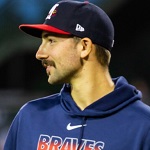 Spencer Strider, RHP
Spencer Strider, RHP
Age: 23
3.64 ERA | 2.80 FIP | 22 G, 21 GS | 94.0 IP | 3.83 BB/9 | 14.65 K/9 (AAA/AA/A+/A)
Acquired: Drafted, 4th Round – 2020
Prior Ranking: 6
GRADUATED! He was #5 on this list.
The organization was careful with Strider coming out of minor league spring training, holding his pro debut back until the second week of the season and carefully ramping up his pitch count. The wait as worth it however, as he quickly established that low-A was child’s play for him as he allowed only 1 run in 15.1 innings over 4 starts while striking out an eye-popping 32. June saw Strider jump to high-A Rome, where the results were similar, 4 runs in 14.2 innings over 3 starts, striking out 24. Strider found some early adversity at the AA level, but over his final seven starts he held batters to a .192/.279/.328 batting line and pitched to a 3.09 ERA, striking out 52 in 35 innings. After giving up 2 earned runs in 5 innings in Mississippi’s Game 3 win in the Double-A South Championship game, Strider got a quick one-game call-up to Gwinnett before getting a surprise final-weekend try-out with the big league Braves.
Strider pretty much threw exclusively fastballs while in low-A, and why not when no one could really touch the high-90s heat spotted where he wanted it. In high-A he started incorporating the spiked curveball, and then at AA he mixed in the change-up. The fastball is already major-league caliber, and the curve is a potent enough weapon that he likely would find success in a relief role in the majors. However, his ceiling his potentially higher if he can consistently place the change-up where it needs to be, and that will likely be a focus of his development in 2022.
While adding him to the 40-man roster for his weekend try-out was exciting, an unintended consequence is that he will not attend spring training as the lockout continues. That said, Strider is on a track for a major role in Atlanta, possibly as soon as mid-season 2022.
 Ryan Cusick, RHP
Ryan Cusick, RHP
Age: 22
2.76 ERA | 1.53 FIP | 6 G, 6 GS | 16.1 IP | 2.20 BB/9 | 18.73 K/9 (A)
Acquired: Drafted, 1st Round — 2021
Prior Ranking: 10
On Monday, March 14, Ryan Cusick was traded to the Oakland A’s. He was #9 on this list.
Cusick arrived in Augusta in mid-August after being selected with Atlanta’s first-round pick and did pretty much what was advertised — struck a bunch of hitters out with high-octane gasoline.
Touching 100 mph in nearly every one of his 6 outings for the GreenJackets, Cusick was more than a match for low-A hitters. Cusick backed up the fastball with a plus curve that was thrown harder and with more bite than what he typically exhibited in college. Cusick is a control-over-command pitcher currently and would occasionally get beat when falling into a pattern and getting out over the plate, but his stuff was good enough to get away with it most of the time.
Cusick will likely start the season with high-A Rome, looking to hone his command and possibly add back the change-up he threw in college. If the Braves decide that relieving is where Cusick’s future lies, he could make a Spencer Strider-like push to the majors quickly. If not, he’ll be a slower burn, but could still end up in AA by the end of 2022 season if he progresses.
 Tucker Davidson, LHP
Tucker Davidson, LHP
Age: 25
2.25 ERA | 3.56 FIP | 7 G, 7 GS | 40.0 IP | 2.70 BB/9 | 9.00 K/9 (MLB/AAA)
Acquired: Drafted, 19th Round — 2016
Prior Ranking: 7
On Tuesday, August 2 Tucker Davidson was traded to the Los Angeles Angels. He was #10 on this list.
The last impression most fans will have of Davidson is that of a nervous, rusty youngster pressed into a starting assignment in the World Series four and a half months after his previous major league start. That assignment went about as well as you’d expect, but it does give some idea of the level of confidence the organization has in Davidson when other options — Drew Smyly, Touki Toussaint, Kyle Muller, even Jesse Chavez as an opener — were available. If the squad enters spring training with a rotation opening, Davidson will be one of the favorites to fill it.
Davidson showed increased velocity and movement on his fastball and sharper secondaries, with a new emphasis on a slider. The curve had traditionally been his best breaker coming up through the system, but the slider surpassed it in effectiveness in 2021. Davidson seemed to have nailed down the fifth starter roll by mid-June, but a tight left forearm forced him to the disabled list, not to return until the World Series. Davidson did show slightly improved command both in his AAA and MLB outings prior to his injury; continued improvement in this area could further cement his spot in a major league rotation.
Being able to return from the forearm tightness without needing surgery was a big positive for Davidson; he will take that, his improved slider, and his postseason experience into 2022 looking to solidify himself as a major league contributor.
 Joey Estes, RHP
Joey Estes, RHP
Age: 20
2.91 ERA | 3.30 FIP | 20 G, 20 GS | 99 IP | 2.64 BB/9 | 11.55 K/9 (A)
Acquired: Drafted, 16th Round – 2019
Prior Ranking: 18
On Monday, March 14, Joey Estes was traded to the Oakland A’s. He was #14 on this list.
Estes put in the most dominating performance by a teenage starting pitcher at low-A for a Braves affiliate since Bryse Wilson and Joey Wentz tag-teamed the SAL in 2017. Estes and Augusta teammate Vaughn Grissom have so far been the most promising of the bevy of overslot prep players from Day 3 of the 2019 draft.
Estes relies heavily on his mid-90s fastball that he zings into the zone from a low 3-quarters delivery, giving hitters an odd angle for a pitch delivered that quickly. His strikeout secondary is a slider that varies in its shape but is generally fairly loopy. He also has a developing change-up. Estes has good control, and when he misses tends to miss in the zone. This will be something to watch for as he ascends the organizational ladder. Estes does not currently have a go-to pitch to get groundballs, and is an extreme flyball pitcher, also something to keep an eye on going forward.
Estes should headline the high-A Rome rotation in 2022. His performance in low-A Augusta was very promising, but he still has several questions to answer regarding his command, his repertoire, and his delivery.
Dylan Lee, LHP
GRADUATED! He was #30 on this list.
Lee took full advantage of a minor league free agent deal with Atlanta just prior to the start of the season after being released by the Marlins organization to end up with the major league squad for the last weekend of the season, then improbably pressed into playoff duty, getting into three games, including a start as an “opener” for Game 4 of the World Series. Lee accomplished this by improving his already solid command, rarely giving hitters anything, and improving his change-up and throwing it more often. Lee will be in the mix for the Atlanta bullpen at the start of the season.
Trey Harris, OF
On Monday, August 1 Trey Harris was traded to the Washington Nationals. He was #36 on this list.
Perhaps no Braves prospect has been hampered more by the pandemic shutdown than Harris, who had a strong 2019 on the strength of a good hit tool that saw him advance to AA Mississippi and have success in the Arizona Fall League. The 2021 season however saw him hit too many ground balls to sustain success. Harris makes a lot of contact and walks very little, so getting those ground balls turned into line drives at least will be key to his continued advancement.
Andrew Hoffmann, RHP
On Monday, July 11, Andrew Hoffmann was traded to the Kansas City Royals. He was #40 on this list.
A workhorse pitcher drafted in the 12th round of the last draft, Hoffmann had success at Augusta with a four pitch repertoire and some good deception. Likely to lead Rome in innings in 2022.
